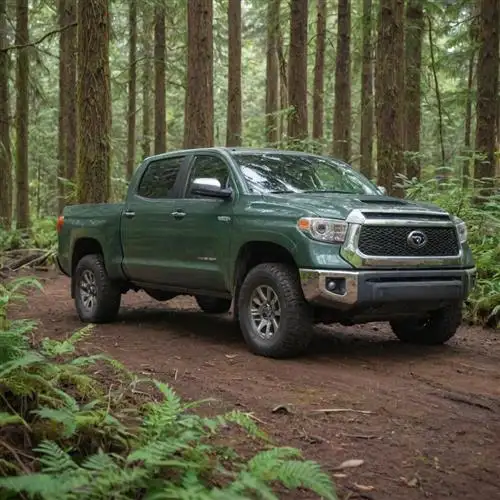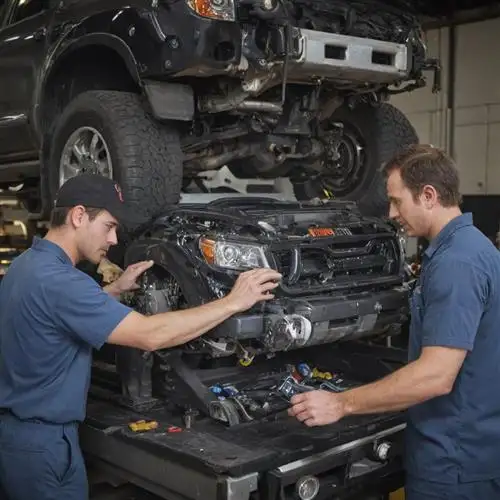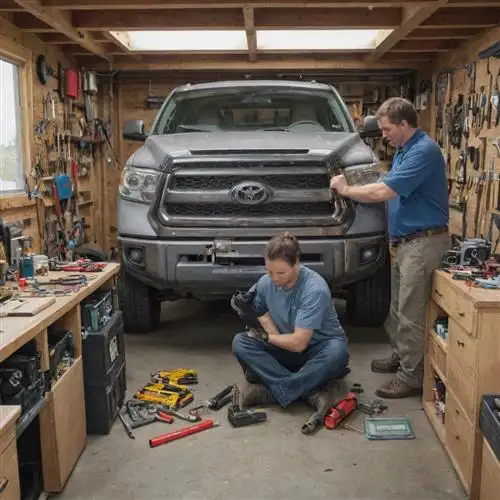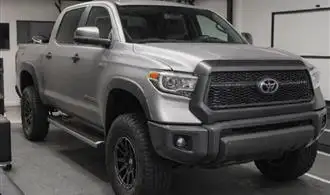
Consequences of Neglected Tundra Maintenance
Owning a Toyota Tundra is a source of pride for many truck enthusiasts, but neglecting its maintenance can lead to disastrous consequences. The Tundra is a workhorse, designed to tackle tough jobs, but it requires consistent care to keep it running at its best. Ignoring essential maintenance tasks can result in a range of problems that can cost you time, money, and even the safety of your vehicle.
One of the most severe consequences of neglected Tundra maintenance is engine failure. The Tundra's powerful engine is the heart of the vehicle, and without proper care, it can quickly deteriorate. Neglecting oil changes, failing to replace worn-out spark plugs, or ignoring issues with the fuel system can all lead to costly engine repairs or even a complete engine replacement.
Neglected maintenance can also take a toll on the Tundra's transmission. The transmission is responsible for delivering power from the engine to the wheels, and if it's not properly serviced, it can experience premature wear and tear. Failing to replace the transmission fluid or neglecting to address any issues with the gears can result in transmission failure, which can be an incredibly expensive repair.
Another critical aspect of Tundra maintenance is the braking system. The Tundra's large size and weight demand a reliable braking system to ensure safe operation. Neglecting to replace worn-out brake pads or failing to service the brake calipers and rotors can compromise the braking performance, putting you and others on the road at risk.
The Tundra's suspension system is also critical to its performance and safety. The suspension components, such as the shocks, struts, and ball joints, wear down over time and need to be replaced. Ignoring these maintenance tasks can lead to a bumpy, unstable ride, and in severe cases, it can even cause the Tundra to lose control on the road.
Neglecting the Tundra's electrical system can also lead to a host of problems. Issues with the alternator, battery, or wiring can cause the vehicle to malfunction, leaving you stranded and unable to rely on your Tundra when you need it most.
Preventative Maintenance Tips for Tundra Owners
Maintaining your Toyota Tundra is crucial to ensure its longevity and peak performance. Neglecting regular maintenance can lead to costly repairs and, in the worst-case scenario, complete failure. As a Tundra owner, you need to be proactive in addressing potential issues before they escalate. Here are some essential preventative maintenance tips that will help you keep your Tundra running smoothly and reduce the fear of costly breakdowns.
Adhere to the Manufacturer's Recommended Maintenance Schedule: Toyota provides a comprehensive maintenance schedule for the Tundra, outlining the specific tasks that should be performed at various mileage intervals. It's imperative that you follow this schedule diligently, as it ensures that critical components are inspected, serviced, and replaced when necessary. Neglecting these routine maintenance tasks can lead to premature wear and tear on your vehicle.
Regular Oil Changes and Fluid Checks: The oil in your Tundra is the lifeblood of the engine. Changing the oil and filter at the recommended intervals is crucial to prevent engine wear and ensure optimal performance. Additionally, regularly checking and maintaining other fluids, such as transmission fluid, brake fluid, and coolant, will help prevent issues down the line.
Brake System Maintenance: The brakes on your Tundra are responsible for your safety, so it's essential to keep them in top condition. Regularly inspecting the brake pads, rotors, and calipers, and replacing them when necessary, will help ensure your brakes are functioning at their best. Don't wait until you notice a problem, as this can lead to more significant and costly repairs.
Tire Rotation and Wheel Alignment: Proper tire maintenance is crucial for your Tundra's handling, fuel efficiency, and overall longevity. Rotating your tires at the recommended intervals and ensuring the wheels are properly aligned can help extend the life of your tires and improve your vehicle's performance.
Inspect and Replace Filters: Your Tundra's air, fuel, and cabin filters play a vital role in keeping the engine and cabin air clean. Regularly inspecting and replacing these filters as needed will help maintain the efficiency of your vehicle and improve its overall performance.
Attend to Electrical and Computerized Systems: Modern vehicles, including the Tundra, rely heavily on complex electrical and computerized systems. Regularly checking for any warning lights or error codes, and addressing them promptly, can prevent more significant issues from developing. Consider investing in a diagnostic tool to help you identify and resolve any electrical or electronic problems that may arise.
Identifying and Addressing Common Tundra Maintenance Issues
As a proud Toyota Tundra owner, it's crucial to maintain your vehicle to ensure it continues to perform at its best. Neglecting Tundra maintenance can lead to a myriad of issues that can not only impact the vehicle's performance but also your finances and peace of mind. In this article, we'll delve into the common maintenance challenges Tundra owners face and provide practical solutions to address them.
One of the most critical aspects of Tundra maintenance is regular oil changes. The Tundra's powerful engine requires high-quality oil to function optimally. Failing to change the oil at the recommended intervals can lead to increased wear and tear, reduced fuel efficiency, and even engine failure. Be diligent about following the manufacturer's recommendations, and consider using a reputable oil change service to ensure the job is done right.
Another common issue with the Toyota Tundra is the potential for brake problems. Over time, the brake pads and rotors can wear down, reducing the vehicle's stopping power. Regular brake inspections and timely replacements are essential to maintaining the Tundra's safety and performance. Keep an eye out for signs of worn brakes, such as squeaking or decreased responsiveness, and address any issues promptly.
Tire maintenance is also crucial for the Tundra. The large, off-road-capable tires on the Tundra require proper inflation and regular rotation to ensure even wear and optimal performance. Underinflated or unevenly worn tires can impact fuel efficiency, handling, and even safety. Invest in a reliable tire pressure gauge and follow the manufacturer's recommended tire pressure guidelines.
One often overlooked aspect of Tundra maintenance is the suspension system. The Tundra's rugged suspension is designed to handle off-road adventures, but it also requires regular attention. Signs of suspension issues may include a bouncy ride, uneven tire wear, or difficulty with steering. Addressing suspension problems early can prevent more significant and costly repairs down the line.
For those looking to Why Customizing Your Toyota Tundra is a Game-Changer, it's essential to ensure the vehicle is properly maintained. Customizations, such as lift kits or larger tires, can put additional strain on the Tundra's systems, making regular maintenance even more critical.
DIY Tundra Maintenance Hacks for Budget-Conscious Owners
Maintaining your Toyota Tundra doesn't have to break the bank. As a budget-conscious owner, you can employ a range of DIY maintenance hacks to keep your truck running smoothly. From simple tasks like oil changes to more complex projects, these tips will help you save money while ensuring your Tundra remains in top condition.
One of the most cost-effective maintenance tasks is regular oil changes. While it may be tempting to take your Tundra to a quick lube shop, you can easily perform this job yourself with a few basic tools. Investing in high-quality oil and filters will not only protect your engine but also extend the life of your vehicle.
Tire maintenance is another area where DIY efforts can pay off. Regularly checking and rotating your tires can improve fuel efficiency and extend their lifespan. Consider investing in a tire pressure gauge and learn how to properly inflate your tires to the recommended PSI. Additionally, you can save on costly tire replacements by learning how to patch minor punctures or balance your own wheels.
For those more mechanically inclined, tackling minor repairs and upgrades can be a rewarding experience. Transform Your Toyota Tundra Performance in 30 Days by researching and installing performance-enhancing parts, such as air filters, exhaust systems, or suspension components. Not only will this improve your Tundra's capabilities, but it can also be a satisfying DIY project.
Keeping your Tundra's exterior clean and well-maintained is another area where you can save money. Instead of relying on expensive car washes, invest in a high-quality car wash kit and learn the proper techniques for washing and waxing your vehicle. This will not only preserve the paint but also protect the underlying surfaces from the elements.
Tundra Maintenance Schedules and Checklists for Optimal Performance
Maintaining your Toyota Tundra at optimal performance is crucial to ensure its longevity and reliability. The key lies in adhering to a comprehensive maintenance schedule and checklists. Regular oil changes, tire rotations, and brake inspections are just the tip of the iceberg. To truly keep your Tundra in top shape, you must delve deeper into the maintenance requirements.
The Toyota Tundra maintenance schedule is designed to cover a wide range of components, from the engine and transmission to the suspension and electrical systems. It's recommended to follow the manufacturer's guidelines religiously, as neglecting these tasks can lead to costly repairs down the line. For instance, failing to replace the timing belt or water pump at the specified intervals can result in engine failure, leaving you stranded on the road.
Alongside the maintenance schedule, creating a detailed checklist can be immensely helpful. This checklist should include tasks such as checking the air filter, inspecting the brake pads and rotors, and ensuring the fluid levels are within the recommended range. By systematically going through this checklist, you can identify potential issues before they escalate and address them promptly.
Furthermore, it's essential to pay attention to any warning signs or changes in your Tundra's performance. If you notice unusual noises, decreased fuel efficiency, or any other concerning behaviors, it's crucial to have your vehicle inspected by a qualified technician. Addressing these issues early can prevent them from turning into larger, more expensive problems.
Proper Tundra maintenance is not only about ensuring optimal performance but also about safeguarding your investment. By keeping your vehicle well-maintained, you can maximize its resale value and avoid costly repairs down the line. Remember, a well-cared-for Tundra will serve you faithfully for years to come.
In addition to routine maintenance, it's important to consider the Towing Essentials Every Toyota Tundra Owner Should Know. Proper towing practices and equipment can protect your Tundra from damage and ensure the safety of both you and other drivers on the road.
















